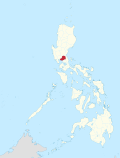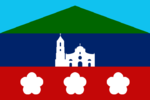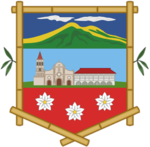Federal Republic of Augustin
| 2022 | |||||||
| Motto: "Kalayaan, Pagkakapantay-pantay, Kapatiran" (Filipino) Liberty, Equality, Fraternity | |||||||
| Anthem: La Maloloseniana | |||||||
 Location of the Federal Republic of Bulacan | |||||||
| Capital | Hagonoy | ||||||
| Largest city | San Jose del Monte | ||||||
| Official languages | Filipino Spanish English | ||||||
| Ethnic groups | Tagalog 90% Kapampangan 4% Pangasinan 1.5% Others 0.9% | ||||||
| Religion | Roman Catholic | ||||||
| Demonym(s) | Bulakenyo/Bulakenya (Tagalog) Bulaqueño/Bulaqueña (Spanish) | ||||||
| Government | Federal parliamentary republic | ||||||
| Chris Walsh | |||||||
| Chris Walsh | |||||||
| Legislature | Parlamento | ||||||
| Establishment | |||||||
| History | |||||||
• Bulacan declares independence | 25 January 2022 | ||||||
• Established | 2022 | ||||||
| Area | |||||||
• Total | 2,796.10 km2 (1,079.58 sq mi) | ||||||
| Population | |||||||
• 2022 census | 1 | ||||||
| Currency | Bulacan corona (BCR) | ||||||
| Time zone | Philippine Standard Time (PhST) | ||||||
| Date format | yyyy.mm.dd | ||||||
| Driving side | left | ||||||
| |||||||
Not to be confused with Bulacan, a province in the Philippines and Bulakan, Bulacan, a municipality in the Province of Bulacan.
The Bulaqueño Federal Republic, more commonly known as Bulacan, is a self-proclaimed state located in the Philippine archipelago.
Bulacan was established by a declaration of sovereignty as a successor state of the Malolos Republic after its dissolution on April 1901.
Etymology
Bulacan is derived from the Tagalog word 'bulak' meaning cotton, which was its former principal product. Bulacan started with small fishing settlements along the coast of Manila Bay and expanded into the interior with the arrival of the Spaniards.
History
Prehistory
Spanish colonization
The Conquest of Bulacan traces to the first years of the Spanish in the Philippines. Upon the defeat of the Macabebe and Hagonoy natives led by Bambalito in the Battle of Bangkusay on June 3, 1571, that caused Martin de Goiti to move up north first to Lubao in September 1571.
Two months later, on November 14, 1571, Martin de Goiti reached Malolos and Calumpit respectively and it was reported to Adelantado Miguel Lopez de Legaspi, the first Governor-General of the Philippines. Adelantado established Calumpit and Malolos as an Encomienda entrusted to Sargento Juan Moron (Morones in other documents) and Don Marcos de Herrera. These two conquistadores was one of the first group of conquerors accompanied by Legaspi who have arrived in the Islands in 1565.
On April 5, 1572, the Encomiendas of Calumpit and Malolos were unified co-administered by Moron and Herrera. Also on that year, Alcaldia de Calumpit was formed in which the areas of Macabebe, Candaba, Apalit in Pampanga, and the settlements of Meyto, Panducot, Meysulao, and Malolos. And on December 28, 1575, Governor-General Francisco Sande order to include Hagonoy in Calumpit. (NHCP Journal February 2015)
In 1575, Bulakan was established as a visita of Tondo and it is not part of Calumpit as the boundary between Tondo and Calumpit was marked in Mambog River and placed the statue of Our Lady of Visitacion (patroness of Calumpit) was erected. It was gone and recreated in 1997 upon the re-establishment of the Roman Catholic Parish of Our Lady of Presentacion in Malolos.
On April 30, 1578, Bulakan town was officially established by the Augustinians with Fray Diego Vivar as its first prior and the convent was dedicated to San Agustin. (when it was changed to Our Lady of Assumption was uncertain). It was reported that the western part of the present-day Bulacan was to be very well populated and rich. No exact date and year when Alcaldia de Calumpit was dissolved and the exact foundation year of the Province of Bulacan. It was only documented that Malolos (then part of Calumpit in 1572) was first to appear as part of Alcaldia de Bulacan was in 1582. It may be assumed that the reorganization of encomiendas has occurred between 1580 and 1582 at the time of Governor-General Gonzalo Ronquillo de Penalosa.
Same document also from the 1582 Relacion de las Islas Filipinas by Miguel de Loarca reports that Alcaldia de Calumpit have the jurisdiction in the areas of Calumpit (capital) Capalangan, Cabangbangan and Hagonoy as its villages. Then Loarca was mentioned that Alcaldia de Bulacan have Bulakan (capital) Malolos, Caluya, Guguinto, Binto and Catanghalan (instead of Meycauayan) as it Encomiendas which formerly have one alcalde mayor but he said that Alcaldia de Bulacan was formed in 1580 at the time of Penalosa. In the document of Governor-General Luis Perez de Dasmarinas in the Account of the Encomiendas for the King of Spain furnished on June 21, 1591. Dasmarinas mentioned that Alcaldia of Bulacan was part of La Pampanga with the Encomiendas subject to it such as the Encomiendas of Malolos (3,600 persons), Binto (2,000 persons), Guiguinto (2,000 persons), Caluya (2,800 persons), Mecabayan (2, 800 persons) and Bulacan identified as " capital" and residence of "alcalde mayor" with 4,800 persons. In the same 1591 document, it was mentioned that Calumpit y Hagonoy belongs to Juan Moron with the 12,800 persons, 2 Augustinian Convents, and One Alcalde Mayor of its own.
However, the establishment and development of the southern part of the present-day Bulacan was not simultaneous and identified with the West. It was because this part of the Province was established by another group of missionaries, the Franciscan Order who came to the islands only in 1577 in Manila. In 1578 Order of Friars Minor headed by Juan de Plasencia and Diego Oropesa arrived in the area called Toril (now part of Meycauayan) and their headquarters. Also in 1578 Plasencia established the Town of Meycauayan. Its pueblos were first only settlements of the Old Meycauayan, founded by Franciscan
Secondary sources mentioned that Meycauayan exists as a Province in 1578. It was said the Augustinians Christianized Bulacan (the town after which the province was named). Were in fact Bulacan "the town" was already a visita of Tondo in 1575 and Calumpit where Malolos and Hagonoy belong in 1572. The province of Bulacan is on the island of Luzon, and is one of the most important Alcadia de Termino, Civil and politically it corresponds to the Audiencia y capitanía general de Filipinas, and spiritually belongs to the Archbishop of Manila. The Franciscan friars Juan Plasencia and Fray Diego de Oropesa founded Meycauayan in 1578, and for a time it was the capital of the Province of Meycauayan (differ from the Western Bulacan administered by Augustinian Order since 1572) Meycauayan people were able to flourish and became so rich that the sons are six of the best in the then Province of Meycauayan. It was the towns of Bocaue, Polo, San Jose del Monte, Santa Maria de Pandi, Obando and Marilao).
During the General Visitation of October 5, 1762 by, Sr. Doctor Don Simón de Anda y Salazar, the province was headed by Capitan Don Jose Pasarin, alcalde mayor of the province. 1795–96, Don Manuel Piñon was the alcalde mayor. According to the "Guia de 1839", Bulacan province in the island of Luzon, Philippines, is governed by a mayor, consists of 19 pueblos, 36,394 tributes and 181,970 souls. D. Felipe Gobantes, Alcalde of the province of Bulacan erected a stone column in the plaza of Bulacan in Memory of Fr. Manuel Blanco O.S.A. who died on April 1, 1845.
In 1848, when the boundaries of Pampanga were changed, the region, which includes the important town of San Miguel de Mayumo and neighboring places that were formerly part of Pampanga, was adjudicated to Bulacan.
In an earlier period during 1890, Malolos was a hot-spot of Liberal Ilustrados, notably the "20 Women of Malolos", who exerted pressure for education under a Filipino professor. However, the first phase of the revolution ceased in 1897 with the signing of the Pact of Biak-na-Bato in San Miguel. Under its terms, the leaders were to go to Hong Kong and reside there. Under the illusory peace created by the pact, the end of 1897 saw the greater determination on the part of the Filipinos to carry on the revolution. In early 1898, the provinces of Zambales, Ilocos, Pampanga, Bulacan, Laguna, Pangasinan, Nueva Ecija, Tarlac. and Camarines rose again. In Central Luzon, a revolutionary government was organized under General Francisco Macabulos, a Kapampangan revolutionary leader of La Paz, Tarlac.
The Americans established a local Philippine government in the Philippines when they held the first municipal election in the country in the town of Baliuag on May 6, 1899. At the beginning of the American rule, 1899–1900, Malolos became the headquarters of the Military Governor of the Philippines at Casa Real. On February 27, 1901, the Philippine Commission officially transferred the seat of government to Malolos, and the Casa Real de Malolos was the seat of the Provincial Governor from 1900 to 1930 until the completion of the capitol building at Barangay Guinhawa, Malolos City.[clarification needed]
In 1942, at the height of World War II, the Japanese Imperial Army occupied Bulacan and made Casa Real de Malolos its headquarters. In 1945, combined Filipino and American forces and local guerrillas attacked the Japanese Imperial Forces and liberated Bulacan.
Through Presidential Decree № 824, Bulacan was partitioned on November 7, 1975, to form the National Capital Region. The municipality of Valenzuela was excised to form the new region, while the other 25 towns remained in Bulacan.
Issue concerning the founding date of the Province
For a long period of time, Bulacan traced its founding as a province during the American Period at the reorganization of Philippine Provinces. To determine the tentative date of the province's foundation and to trace its roots from colonial period. Efforts and research conducted by Dr. Jaime Veneracion, Dr. Reynaldo Naguit of the Center for Bulacan Studies and Mr. Isagani Giron of the Samahang Pangkasaysayan ng Bulacan (Sampaka) shows that Bulacan was identified as a visita of Tondo in 1578. With regards to exact date of foundation of Bulacan as a province, Veneracion correlated it with the practice of Spaniard of dedicating the founding a pueblo to the feast of a patron saint. In the case of Bulacan it is the Nuestra Señora de la Asuncion, which is also the patron saint of Bulakan town, the first capital of the province. Officially, the province of Bulacan was created under Act 2711 on March 10, 1917.
Micronational period
The Federal Republic of Bulacan was founded by Chris Walsh, the first and current president of Bulacan.
Government and politics
| Party Name | Emblem | Leader(s) | Position | Seats in Parliament |
|---|---|---|---|---|
| Liberal Party (LP) |  |
Chris Walsh | Liberalism | 1 / 7
|
| Monarchist Party (MON) | vacant | Monarchism | 0 / 7
| |
| Labour Party of Bulacan (LPB) |  |
vacant | Social democracy, Democratic socialism | 0 / 7
|
| Communist Party of Bulacan (CPB) |  |
vacant | Marxism-Leninism, Agrarianism | 0 / 7
|
| Christian Democratic Party (CDP) |  |
vacant | Christian democracy | 0 / 7
|
Independents/Others |
N/A | N/A | N/A | 0 / 7
|
Geography
Bulacan covers a total area of 2,796.10 square kilometres (1,079.58 sq mi) occupying the southeastern section of the Central Luzon region. The province is bounded by Nueva Ecija (San Isidro Gapan City, General Tinio) on the north, Aurora (Dingalan) on the northeast, Quezon (General Nakar) on the east, Rizal (Rodriguez) on the southeast, Metro Manila (Valenzuela City, Malabon, Navotas, Caloocan and Quezon City) on the south, Manila Bay on the southwest, and Pampanga (Candaba, San Luis, Pampanga, Apalit, Macabebe, Masantol) on the west.
Several rivers irrigate the province of Bulacan; the largest one is that of Angat. Angat River passes through the towns of Norzagaray, Angat, Bustos, San Rafael, Baliwag, Plaridel, Pulilan, and Calumpit. It flows thence into the Pampanga River, goes out again, washes Hagonoy, and loses itself in the mangroves. The banks of these rivers are very fertile and are covered with trees.
Terrain
Bulacan lies in the southern portion of the fertile plains of Central Luzon. The area is drained by the Angat and Pampanga rivers. The Sierra Madre mountain range forms the highlands of Bulacan in the east and is a protected area known as the Angat Watershed Forest Reserve. Angat Lake, which was formed by the Angat Dam is located in that area. The highest point in the province at 1,206 meters is Mount Oriod, part of the Sierra Madre.
On January 19, 2008, an 18-hectare (44-acre) dump site, a new landfill that would also be a tourist attraction opened in Norzagaray, Bulacan province. Ramon Angelo, Jr., president Waste Custodian Management Corp. stated: "I want them to see our system in our place which should not be abhorred because we are using the new state-of-the-art technology."
Climate
November to April is generally dry while wet for the rest of the year. The northeast monsoon (amihan) prevails from October to January bringing in moderated and light rains. From February to April, the east trade winds predominate but the Sierra Madre (Philippines) mountain range to the east disrupts the winds resulting to a dry period. From May to September, the southwest monsoon (habagat).
The hottest month is May having an average temperature of 29.7 °C (85.5 °F) while the coldest is February with an average temperature of 25.1 °C (77.2 °F).
Administrative divisions
Demographics
Culture and media
Religion
According to the constitution, Roman Catholicism is the official state religion. Bulaqueños have freedom of religion.

